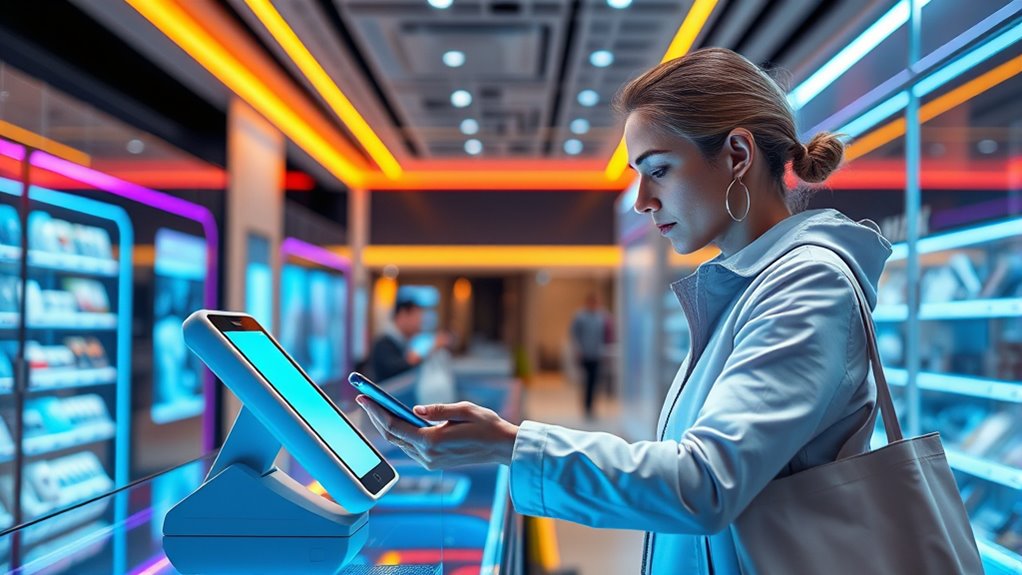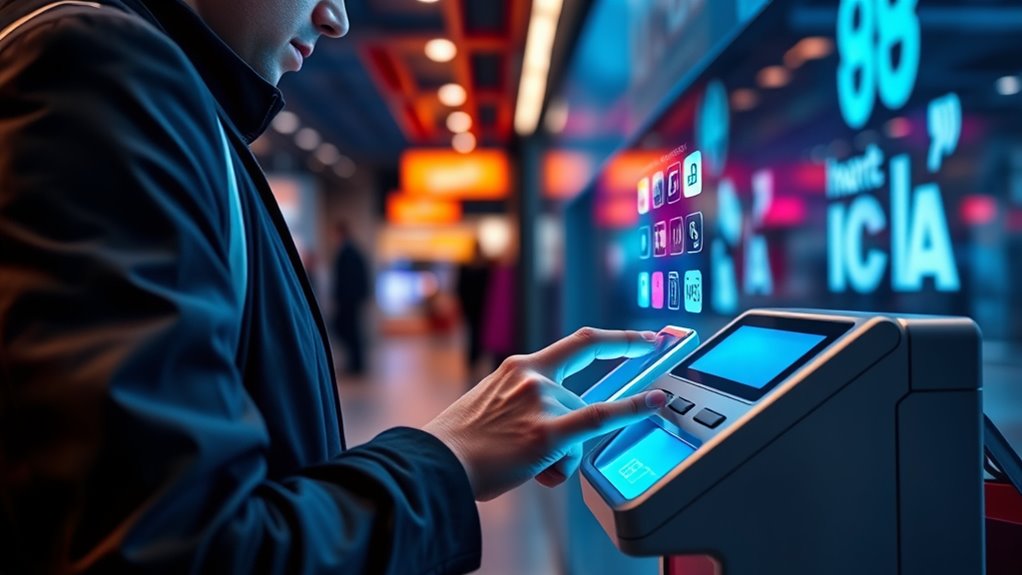By 2026, your tap-to-pay experience will be faster, more secure, and effortless thanks to advances in contactless and biometric technology. You’ll use mobile devices and digital currencies seamlessly across different sectors, with new features like multi-factor authentication and expanded cryptocurrency options making transactions safer and more private. Specialized hardware and evolving security measures will reduce fraud and speed up checkout. Stay tuned—you’ll discover how these innovations will transform your everyday payments even further.
Key Takeaways
- Contactless payment methods will become more widespread, enabling faster transactions through tap or swipe gestures.
- Cryptocurrency integration will expand, allowing direct payments with diverse digital assets via mobile devices.
- Biometric authentication will evolve with multi-factor methods, enhancing security and reducing fraud risks.
- Hardware innovations, like secure chips and contactless terminals, will improve transaction safety and speed.
- Overall, mobile and contactless payments will be more seamless, secure, and integrated across various sectors by 2026.

In today’s fast-paced world, mobile and contactless payments have revolutionized the way you shop and pay for goods and services. With just a tap or a swipe, you can complete transactions quickly and securely, eliminating the need for cash or physical cards. As technology advances, these payment methods are becoming even more seamless, integrating new features like cryptocurrency and biometric authentication to enhance your experience. Cryptocurrency integration allows you to pay directly with digital currencies, making international transactions faster and more cost-effective. Instead of converting currencies or waiting days for bank transfers, you can use your mobile device to pay with popular cryptocurrencies, all within a secure and user-friendly interface. This shift not only broadens your payment options but also offers increased privacy and control over your financial assets. Additionally, specialized hardware such as contactless payment terminals and secure chips further reinforce the security and ease of these transactions.
Biometric authentication plays a vital role in making these transactions safer and more convenient. Instead of entering passwords or PINs, you simply use your fingerprint, facial recognition, or even iris scans to verify your identity. This technology reduces the risk of fraud and unauthorized access, giving you peace of mind when making purchases. As biometric security becomes more widespread, you’ll notice fewer friction points during checkout, speeding up the process and reducing errors. Combined with contactless technology, biometric authentication ensures that your payments are both quick and secure, even in busy or high-risk environments.
Looking ahead to 2026, it’s clear that these innovations will continue to evolve. Cryptocurrency integration will likely expand to include more mainstream digital assets, enabling you to pay with a broader range of tokens directly from your mobile wallet. Meanwhile, biometric authentication will become more sophisticated, utilizing multi-factor methods to verify your identity with even greater accuracy. These advancements will make mobile and contactless payments more intuitive and secure, encouraging wider adoption across various sectors—retail, transportation, hospitality, and beyond. You’ll enjoy the convenience of making payments with a simple tap, while knowing your financial information is protected by cutting-edge security measures. As the landscape shifts, your ability to manage money on the go will become more versatile, integrated, and secure, transforming the way you handle everyday transactions.
Frequently Asked Questions
Will Tap-To-Pay Work Offline in 2026?
Yes, tap-to-pay will work offline in 2026. You’ll be able to complete offline transactions using stored data on your device, but it requires data synchronization once you’re back online. This guarantees your transaction history updates correctly and security remains intact. Offline payments will be convenient for quick, contactless purchases, especially where internet access is limited, making your transactions smoother without sacrificing security or functionality.
How Secure Are Contactless Payments Against Fraud?
They say a chain is only as strong as its weakest link, and contactless payments are no different. You’re protected by biometric authentication and transaction encryption, which makes it tough for fraudsters to succeed. While no system is foolproof, these security measures markedly reduce the risk of theft or fraud, giving you confidence that your payments are safe. Stay vigilant, but rest assured your contactless payments are designed to keep you secure.
Will Physical Cards Become Obsolete by 2026?
By 2026, physical cards may become less common, but they won’t disappear entirely. You might find that card durability improves, making them last longer, yet accessibility challenges could lead many to rely more on contactless payments. You’ll likely see a shift toward digital wallets and mobile payments, but for now, some still prefer the tangible security of cards, especially in areas with limited digital infrastructure.
How Will Privacy Be Protected With Increased Tap Payments?
Your privacy remains protected like a vault, thanks to strict data privacy measures. As tap payments grow, encryption standards evolve to safeguard your information, making it nearly impossible for hackers to crack. Companies are also implementing tokenization, replacing sensitive data with unique tokens during transactions. So, while your tap-to-pay convenience soars, your personal data stays locked tight, ensuring you can pay confidently without worries about privacy breaches.
What Are the Environmental Impacts of Mobile Payments?
You might be surprised to learn that mobile payments can reduce the environmental footprint by cutting down on paper receipts and plastic cards. They also promote sustainability benefits by encouraging digital transactions, which lower resource consumption. However, the energy used to power servers and devices does have an impact. Overall, mobile payments can be a greener option if energy sources are renewable and electronic waste is properly managed.
Conclusion
By 2026, mobile and contactless payments will become second nature, making transactions faster and more seamless than ever. As you embrace this shift, remember that change is the only constant in tech. Keep your eyes open and adapt quickly; the early bird catches the worm. Staying ahead means you won’t be caught flat-footed when the future of payments is right around the corner. So, get ready to ride the wave and stay connected.









